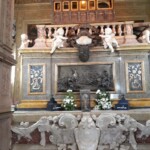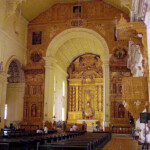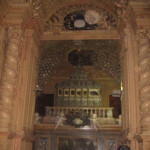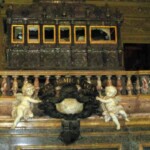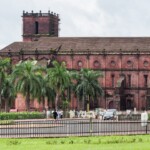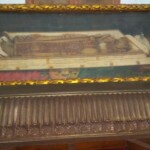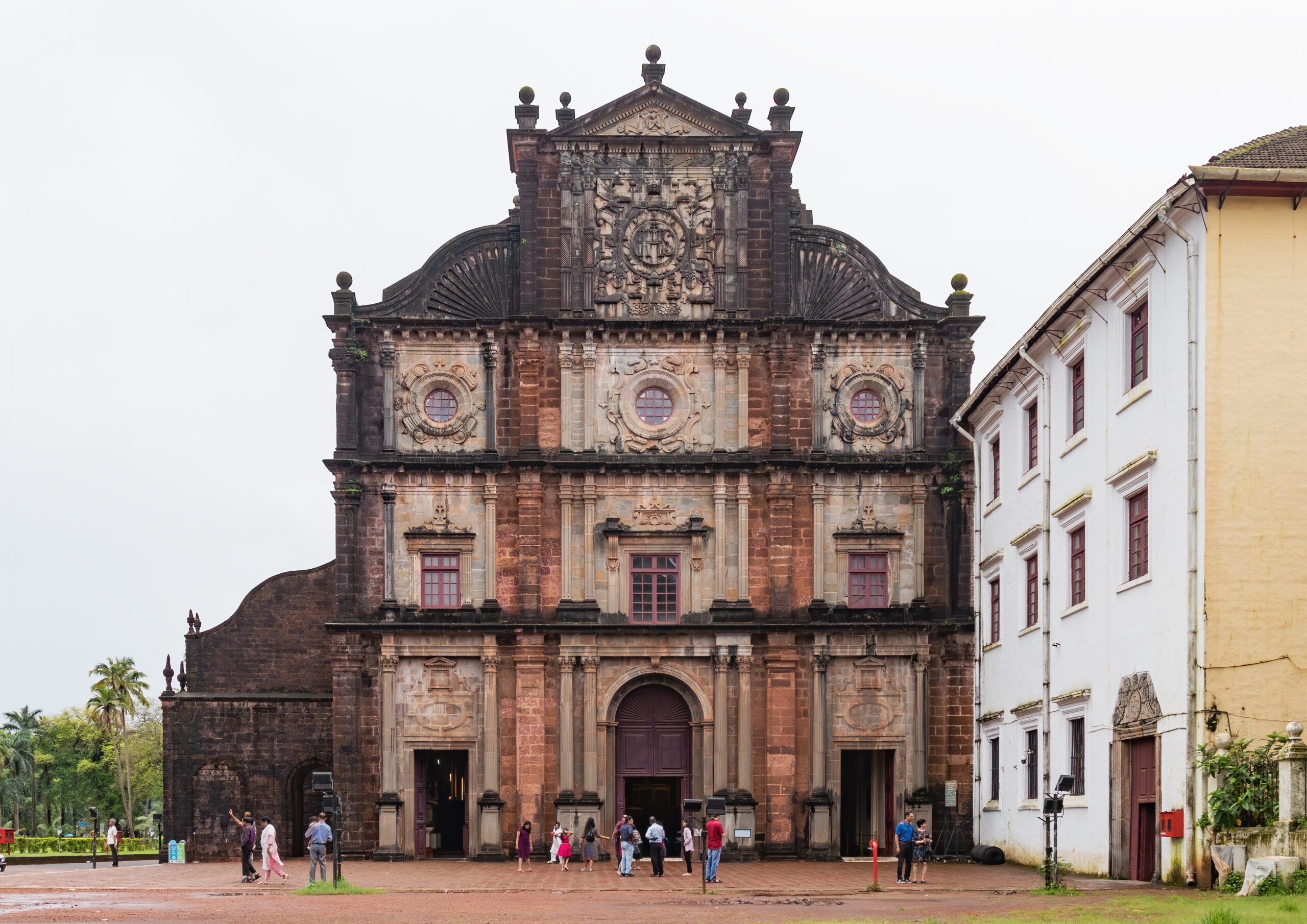
The Tomb of St. Francis Xavier is a sacred and historic monument located inside the Basilica of Bom Jesus in Old Goa, a UNESCO World Heritage Site. It enshrines the mortal remains of St. Francis Xavier, one of the greatest Christian missionaries and co-founder of the Society of Jesus (Jesuits). He arrived in Goa in the 16th century and played a crucial role in spreading Christianity across Asia, including India, Japan, and parts of Southeast Asia.
What makes the tomb truly remarkable is that the saint’s body, despite having died in 1552, is believed to have remained miraculously incorrupt, drawing thousands of pilgrims and tourists from around the world. His body was first brought to Goa in 1554 and eventually placed in a beautifully crafted silver casket designed by Goan artisans between 1636 and 1637. This casket rests atop a grand marble mausoleum gifted by the Grand Duke of Tuscany and created by Florentine sculptor Giovanni Battista Foggini in 1698.
The tomb lies in a side chapel to the right of the main altar, surrounded by ornate carvings, paintings, and scenes from the saint’s life. Every ten years, the saint’s relics are brought out for public veneration during the Solemn Exposition, a major religious event. The annual Feast of St. Francis Xavier is also celebrated with great devotion on December 3rd.
The tomb not only represents religious reverence but also stands as a symbol of Goa’s rich colonial, spiritual, and architectural heritage. It is a must-visit for those interested in history, faith, or art.
History of the Tomb of St. Francis Xavier
The Tomb of St. Francis Xavier is steeped in history and spiritual significance, tracing back to the mid-16th century during the Portuguese colonial era in Goa. St. Francis Xavier, a Spanish Jesuit missionary and co-founder of the Society of Jesus, arrived in Goa in 1542 as part of his mission to spread Christianity in Asia.
Death and Journey of the Body:
St. Francis Xavier died on December 3, 1552, on the island of Shangchuan (off the coast of China). His body was first buried in Malacca (Malaysia), but in 1553, it was exhumed and discovered to be incorrupt—remarkably preserved despite the tropical climate. Believing this to be a divine sign, his followers transported his body to Goa in 1554, where it was received with great reverence and placed in the Church of Bom Jesus (now the Basilica of Bom Jesus).
Tomb Construction:
Initially, the body was laid in a plain wooden coffin, but over the years, its importance grew, prompting the construction of a more elaborate tomb:
In 1637, a silver casket was crafted by Goan silversmiths, richly decorated with 32 embossed panels illustrating scenes from Xavier’s life.
In 1698, a grand marble mausoleum was added, gifted by Cosimo III de’ Medici, the Grand Duke of Tuscany. This was sculpted by renowned Italian artist Giovanni Battista Foggini, blending Baroque and Florentine styles.
The tomb and casket were placed in a specially designed side chapel of the Basilica, to the right of the main altar.
Public Veneration:
Over the centuries, the tomb became a major pilgrimage site. The saint is fondly known in Goa as “Goencho Saib” (Lord of Goa) and revered by people of many faiths. The body is displayed publicly once every ten years during the Exposition of St. Francis Xavier, a grand religious event that draws lakhs of pilgrims from around the world. His annual feast is celebrated on December 3, marking the day of his death.
Legacy:
Today, the tomb stands not just as a resting place for one of Christianity’s greatest missionaries, but also as a symbol of Goa’s spiritual, artistic, and colonial legacy. It continues to inspire devotion and awe, attracting both religious pilgrims and history enthusiasts.
Architecture of the Tomb of St. Francis Xavier
The Tomb of St. Francis Xavier, located inside the Basilica of Bom Jesus in Old Goa, is a remarkable example of Baroque architecture infused with Italian, Portuguese, and Indian influences. It reflects the artistic grandeur of the 16th and 17th centuries, serving both as a religious relic and a masterpiece of sacred art.
Key Architectural Elements:
Location within the Basilica
The tomb is housed in the southern transept (right side) of the Basilica of Bom Jesus, a UNESCO World Heritage Site. The tomb area is part of a richly decorated side chapel, designed to highlight its sanctity and artistic prominence.
Marble Mausoleum (1698)
- Gifted by Cosimo III de’ Medici, Grand Duke of Tuscany.
- Designed by Giovanni Battista Foggini, an acclaimed Florentine sculptor.
- Made of white marble, the mausoleum showcases Baroque aesthetics with elaborate scrolls, floral motifs, and classical detailing.
- It elevates the silver casket on a pedestal, giving it visual dominance in the chapel.
Silver Casket (1636–1637)
- Crafted by local Goan silversmiths using intricate repoussé (hammered relief) techniques.
- Contains 32 detailed silver panels, narrating key events from the life and missionary work of St. Francis Xavier.
- Panels depict scenes such as his voyage to India, his preaching in Japan, and miracles attributed to him.
- The casket is supported by four silver angels, one on each corner, enhancing its visual and symbolic richness.
Wooden Canopy and Balustrade
- A richly carved wooden canopy or baldachin covers the mausoleum, framed by intricately decorated columns and a balustrade.
- This adds a ceremonial feel and draws the eye upward, emphasizing the tomb’s sacred nature.
Interior Frescoes and Gilding
- Surrounding the tomb are painted frescoes, gold-leaf accents, and decorative motifs in Portuguese-Baroque style.
- These artistic elements create a dramatic yet reverent atmosphere, focusing the viewer’s attention on the saint’s resting place.
Images of Tomb of St. Francis Xavier
Visiting Information – Tomb of St. Francis Xavier
The Tomb of St. Francis Xavier is one of Goa’s most sacred and popular pilgrimage sites, located inside the historic Basilica of Bom Jesus in Old Goa. Here’s all the practical information you need for your visit:
Location
Basilica of Bom Jesus, Old Goa, North Goa
- Approximately 10 km from Panaji (Panjim)
- Around 25 km from Dabolim Airport
- Easily accessible by taxi, rental bike, or local bus
Timings:
Day Opening Hours Notes
- Monday Closed Basilica remains shut
- Tuesday–Sunday 9:00 AM – 6:30 PM Entry to tomb and basilica
Last entry usually allowed by 6:00 PM.
Entry Fees:
- Entry: Free
- Guided tours (optional): May be available for a small fee or donation
Best Time to Visit
- November to February – Pleasant weather, ideal for sightseeing
- December 3 – Major crowds visit for the Feast of St. Francis Xavier
- Exposition Year (every 10 years) – The saint’s body is brought out for public viewing; attracts lakhs of pilgrims
Major Events
- Annual Feast: Celebrated on December 3 with special masses and processions
- Solemn Exposition: Held once every 10 years, the next expected in 2034 (last held in Nov 2024 – Jan 2025)
Tips for Visitors
- Dress modestly (it’s a religious site)
- Photography is allowed but avoid flash or disruptions
- Maintain silence and respect during mass or prayer times
- Weekends and feast days can be very crowded—visit early in the day for a peaceful experience
How to Reach the Tomb of St. Francis Xavier
The Tomb of St. Francis Xavier is located inside the Basilica of Bom Jesus in Old Goa, a historic area well-connected to other parts of Goa by road. Here’s how you can reach it:
By Road (Private Car or Taxi)
- From Panaji (Panjim): ~10 km, about 20–25 minutes by car or taxi
- From Dabolim Airport: ~25 km, about 40–45 minutes by taxi
- From Margao: ~35 km, about 1 hour drive
- Taxis, rental cars, and bike taxis are easily available in all major towns and at the airport.
By Two-Wheeler or Self-Drive
- Renting a scooter or motorbike is a popular and budget-friendly option for tourists in Goa.
- Roads are well-paved and scenic, especially along the Mandovi River.
- Ample parking is available near the Basilica complex.
By Bus (Public Transport)
- Frequent buses run from Panaji Bus Stand (Kadamba Bus Terminal) to Old Goa.
- Travel time: 30–40 minutes depending on traffic.
- Very economical, but can get crowded during peak hours and religious festivals.


